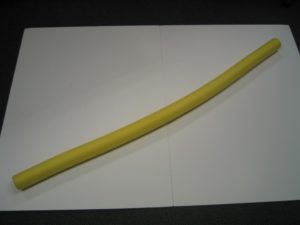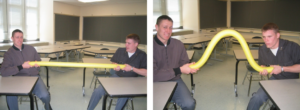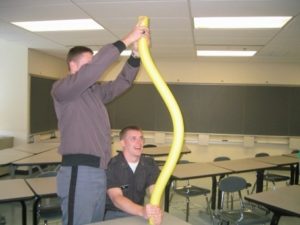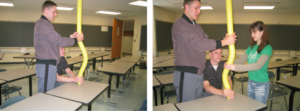Model Description
This is a simple demonstration to show how tension and compression affect members of trusses. A wacky fun noodle (tube floatation device) will be used to demonstrate the effects of tension and compression on axial members. Students pull or push each end to display the desired behavior. This demonstration should take 5-10 minutes.

Engineering Principle
In Mechanics of Materials, the concept and theory of buckling can be demonstrated using the wacky fun noodle.
In statics, the wacky fun noodle can quickly demonstrate that a structural member made of the same material can behave differently and have different strengths during tension and compression (trusses). The demonstration can link the current content to content to be presented in Mechanics of Materials (linking courses).
What You Need
| Item | Quantity | Description/Clarification |
|---|---|---|
|
Wacky Fun Noodle |
1 |
These are foam floatation devices that are many different sizes. The one used here is about 57 inches long (shorter members of 24 inches also work). |
How It’s Done
Before Class: Buy a Wacky Fun Noodle.
In Class: Ask two students of the class to each grab an end of the fun noodle. Have them pull on it first to demonstrate tension. Have them estimate the load they are able to put into the effort (qualitatively). Then have them push on either end, and show that it buckles and bends outward. Have them estimate how much load is required to buckle the wacky fun noodle. Through active discussion, pull out of the students that materials used for truss members generally can support much larger tension loads in comparison with compression loads. Ask the question, since our truss members are 2 force members (tension or compression), is it important to know whether the load the member will support is a tension or compression force? Of course it is since compression forces can cause buckling which could lead to catastrophic failure of the member and possibly the entire truss.

Ask the class what would happen if the length of the noodle where the force is being applied is decreased. Demonstrate, by asking the students to sit closer together as they apply force to the noodle (length decreased), that the effects of tension do not change but the compressive force needed to make it buckle is much greater.

Demonstrate compressive forces acting on the noodle by standing the noodle vertically on a desk. Ask one student to sit in a chair and hold the bottom of the wacky fun noodle and another to stand and push vertically on the top of the noodle so that it buckles. It should buckle in the shape of a C.

Ask another student to hold the noodle loosely in the middle (like a sleeve connection) and ask the students what they think will happen when force is applied to the top. Have the student apply a force vertically to demonstrate to the class that the noodle makes an S-shape because of the constraint in the middle. Ask the student applying the load if more load was required? The answer is yes and theory in Mechanics of Materials will show 4 times as much load is required. K is the factor that takes into account that the length is different based on end conditions. Assuming the end conditions are simply supported and a support is placed at mid-length (i.e., the length becomes L/2), we can see in the equation that the ½ is squared and inverted to estimate 4 times the load required to cause buckling.

Additional Application:
If the student applying the load cannot feel the need for 4 times the load to cause buckling with another student holding the middle, then repeat the two previous steps with a shorter length of the noodle being acted upon. The student applying the force should be able to feel that much more force is needed to make the noodle buckle (four times the amount of force), and the class can once again see the S-shape formed when another student holds the middle of the length of noodle.

With vertical lines drawn along the length and horizontal lines drawn circumferential, torsional behavior can be displayed using the wacky fun noodle. A circular shape when twisted is experiencing pure shear and the squares created by drawing lines on the surface do not change size (area), but change shape (square becomes a rhombus – see rubber shapes physical models).
The wacky fun noodle can be used as a general flexural member as well. The lines draw circumferentially will generally remain straight as the noodle is bent slightly due to flexure – demonstrating plane sections remain plane (see foam beams physical models).
When applying a bending moment, the students can see the top is in compression and the bottom in tension if applying a positive moment.
